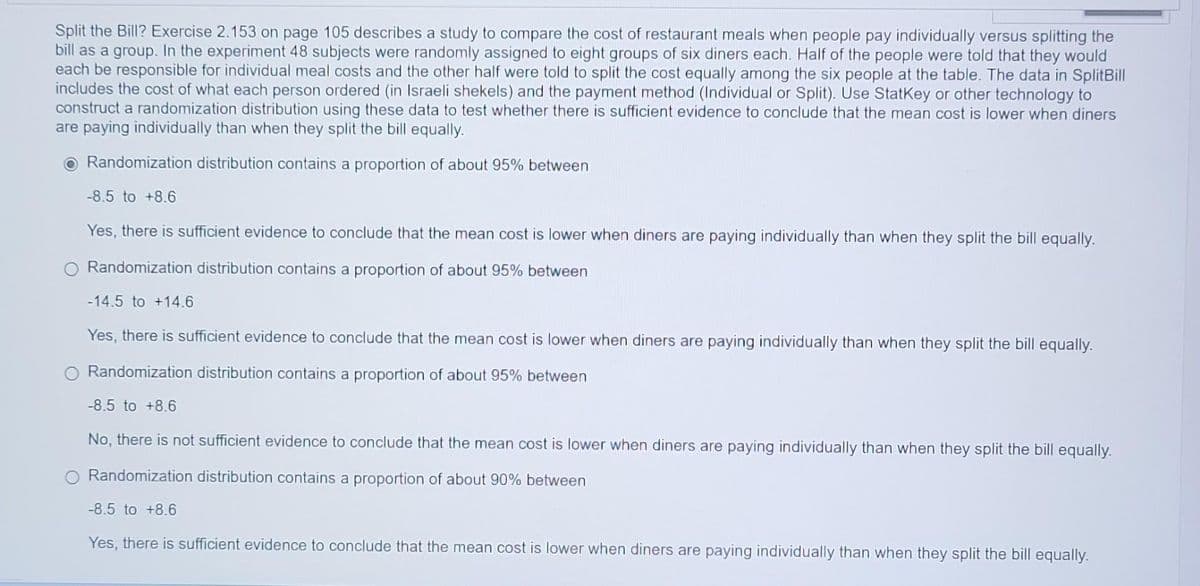153 on page 105 describes a study to compare the cost of restaurant meals when people pay individually versus splitting the periment 48 subjects were randomly assigned to eight groups of six diners each. Half of the people were told that they would ndividual meal costs and the other half were told to split the cost equally among the six people at the table. The data in SplitBill each person ordered (in Israeli shekels) and the payment method (Individual or Split). Use StatKey or other technology to mn distribution using these data to test whether there is sufficient evidence to conclude that the mean cost is lower when diners an when they split the bill equally. bution contains a proportion of about 95% between nt evidence to conclude that the mean cost is lower when diners are paying individually than when they split the bill equally. bution contains a proportion of about 95% between nt evidence to conclude that the mean cost is lower when diners are paying individually than when they split the bill equally. bution contains a proportion of about 95% between Cient evidence to conclude that the mean cost is lower when diners are paying individually than when they split the bill equally. bution contains a proportion of about 90% between nt evidence to conclude that the mean cost is lower when diners are paying individually than when they split the bill equally.
153 on page 105 describes a study to compare the cost of restaurant meals when people pay individually versus splitting the periment 48 subjects were randomly assigned to eight groups of six diners each. Half of the people were told that they would ndividual meal costs and the other half were told to split the cost equally among the six people at the table. The data in SplitBill each person ordered (in Israeli shekels) and the payment method (Individual or Split). Use StatKey or other technology to mn distribution using these data to test whether there is sufficient evidence to conclude that the mean cost is lower when diners an when they split the bill equally. bution contains a proportion of about 95% between nt evidence to conclude that the mean cost is lower when diners are paying individually than when they split the bill equally. bution contains a proportion of about 95% between nt evidence to conclude that the mean cost is lower when diners are paying individually than when they split the bill equally. bution contains a proportion of about 95% between Cient evidence to conclude that the mean cost is lower when diners are paying individually than when they split the bill equally. bution contains a proportion of about 90% between nt evidence to conclude that the mean cost is lower when diners are paying individually than when they split the bill equally.
Glencoe Algebra 1, Student Edition, 9780079039897, 0079039898, 2018
18th Edition
ISBN:9780079039897
Author:Carter
Publisher:Carter
Chapter10: Statistics
Section10.6: Summarizing Categorical Data
Problem 10CYU
Related questions
Question
100%

Transcribed Image Text:Split the Bill? Exercise 2.153 on page 105 describes a study to compare the cost of restaurant meals when people pay individually versus splitting the
bill as a group. In the experiment 48 subjects were randomly assigned to eight groups of six diners each. Half of the people were told that they would
each be responsible for individual meal costs and the other half were told to split the cost equally among the six people at the table. The data in SplitBill
includes the cost of what each person ordered (in Israeli shekels) and the payment method (Individual or Split). Use StatKey or other technology to
construct a randomization distribution using these data to test whether there is sufficient evidence to conclude that the mean cost is lower when diners
are paying individually than when they split the bill equally.
Randomization distribution contains a proportion of about 95% between
-8.5 to +8.6
Yes, there is sufficient evidence to conclude that the mean cost is lower when diners are paying individually than when they split the bill equally.
Randomization distribution contains a proportion of about 95% between
-14.5 to +14.6
Yes, there is sufficient evidence to conclude that the mean cost is lower when diners are paying individually than when they split the bill equally.
Randomization distribution contains a proportion of about 95% between
-8.5 to +8.6
No, there is not sufficient evidence to conclude that the mean cost is lower when diners are paying individually than when they split the bill equally.
Randomization distribution contains a proportion of about 90% between
-8.5 to +8.6
Yes, there is sufficient evidence to conclude that the mean cost is lower when diners are paying individually than when they split the bill equally.
Expert Solution
This question has been solved!
Explore an expertly crafted, step-by-step solution for a thorough understanding of key concepts.
Step by step
Solved in 3 steps with 2 images

Recommended textbooks for you

Glencoe Algebra 1, Student Edition, 9780079039897…
Algebra
ISBN:
9780079039897
Author:
Carter
Publisher:
McGraw Hill

Holt Mcdougal Larson Pre-algebra: Student Edition…
Algebra
ISBN:
9780547587776
Author:
HOLT MCDOUGAL
Publisher:
HOLT MCDOUGAL

Glencoe Algebra 1, Student Edition, 9780079039897…
Algebra
ISBN:
9780079039897
Author:
Carter
Publisher:
McGraw Hill

Holt Mcdougal Larson Pre-algebra: Student Edition…
Algebra
ISBN:
9780547587776
Author:
HOLT MCDOUGAL
Publisher:
HOLT MCDOUGAL